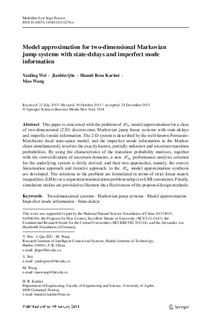Model approximation for two-dimensional Markovian jump systems with state-delays and imperfect mode information
Original version
Wei, Y., Qiu, J., Karimi, H. R., & Wang, M. (2014). Model approximation for two-dimensional Markovian jump systems with state-delays and imperfect mode information. Multidimensional Systems and Signal Processing, 1-23. doi: 10.1007/s11045-013-0276-x 10.1007/s11045-013-0276-xAbstract
This paper is concerned with the problem of {Mathematical expression} model approximation for a class of two-dimensional (2-D) discrete-time Markovian jump linear systems with state-delays and imperfect mode information. The 2-D system is described by the well-known Fornasini-Marchesini local state-space model, and the imperfect mode information in the Markov chain simultaneously involves the exactly known, partially unknown and uncertain transition probabilities. By using the characteristics of the transition probability matrices, together with the convexification of uncertain domains, a new {Mathematical expression} performance analysis criterion for the underlying system is firstly derived, and then two approaches, namely, the convex linearisation approach and iterative approach, to the {Mathematical expression} model approximation synthesis are developed. The solutions to the problem are formulated in terms of strict linear matrix inequalities (LMIs) or a sequential minimization problem subject to LMI constraints. Finally, simulation studies are provided to illustrate the effectiveness of the proposed design methods.
Description
Published version of an article in the journal: Multidimensional Systems and Signal Processing. Also available from the publisher at: http://dx.doi.org/10.1007/s11045-013-0276-x
